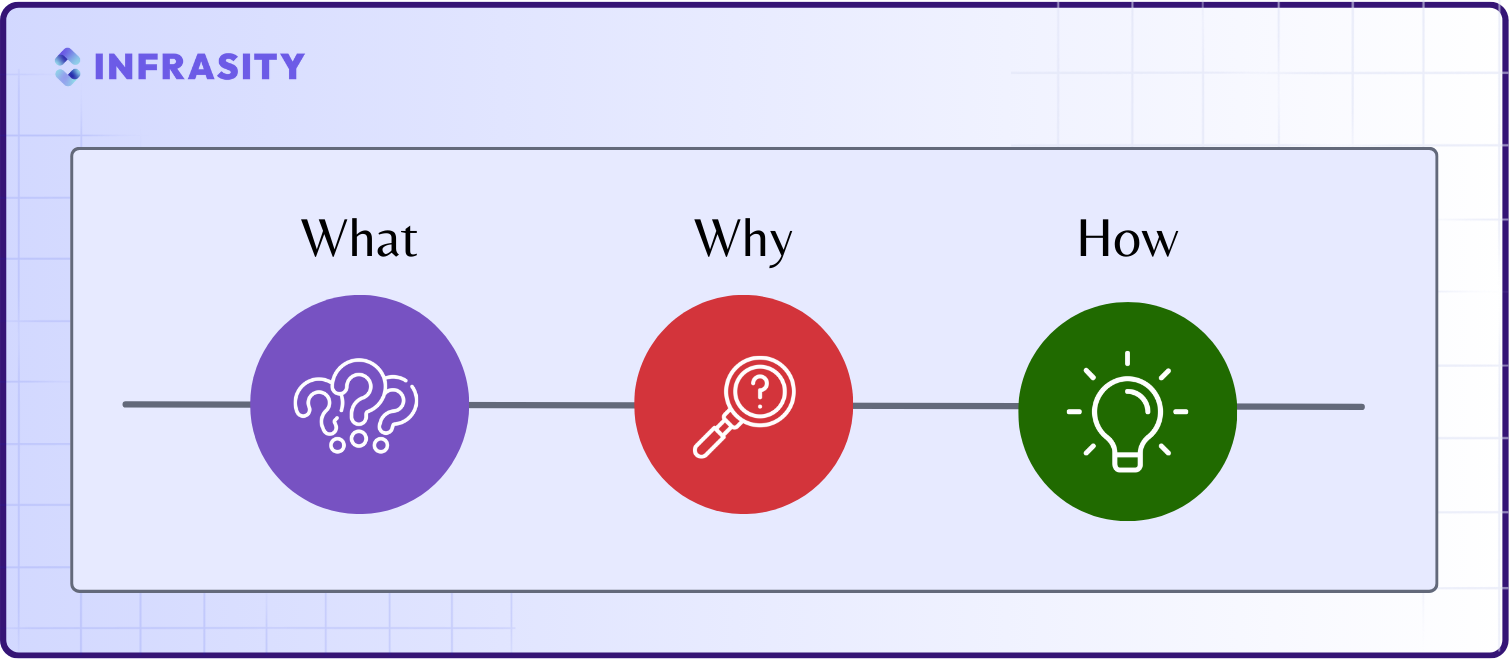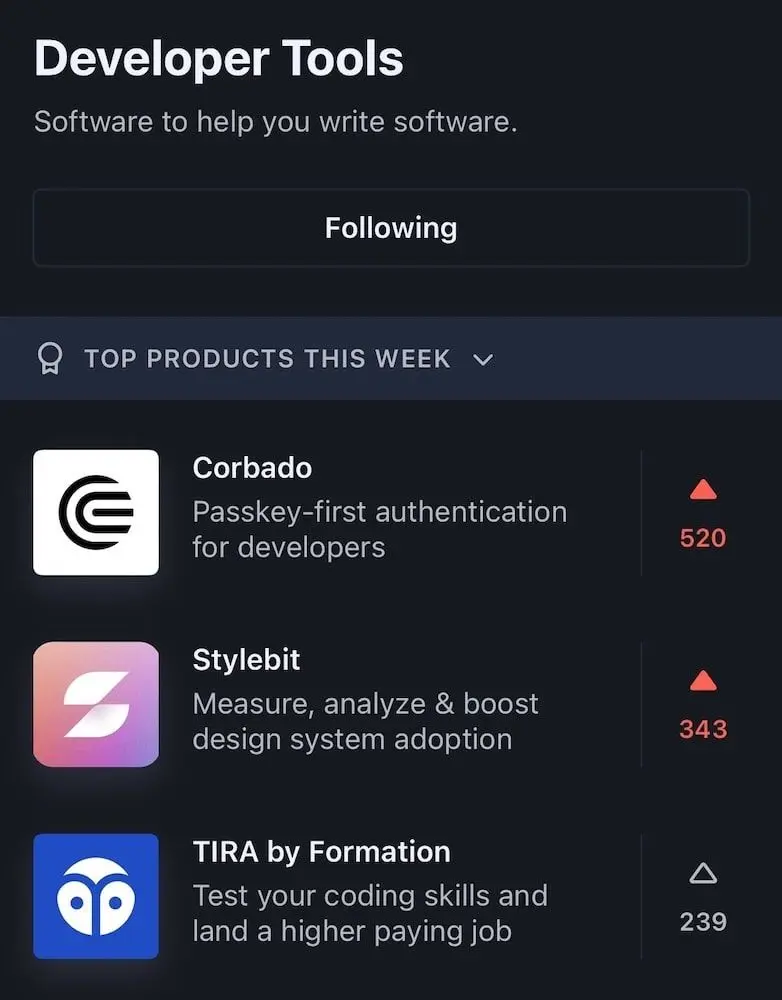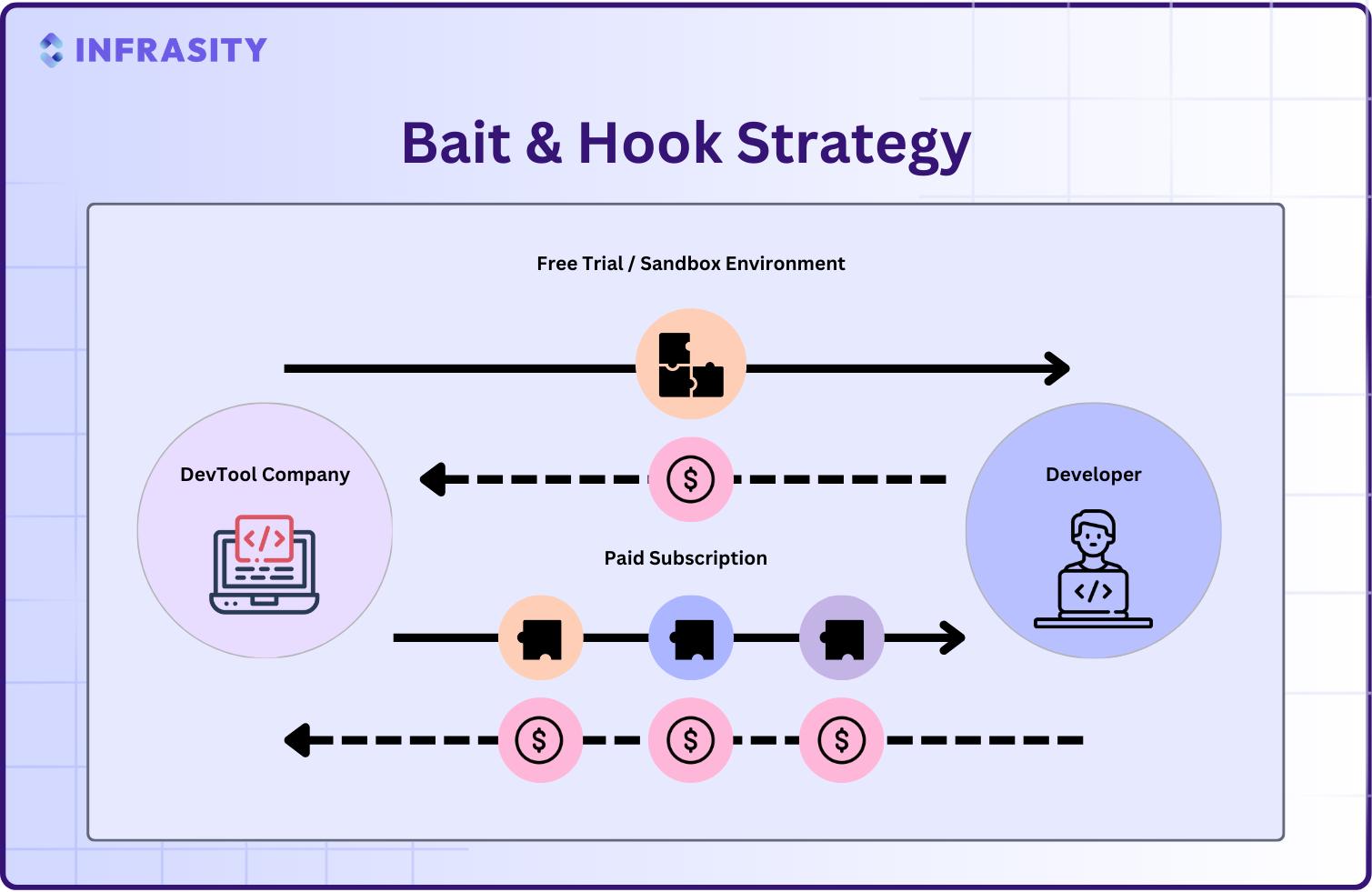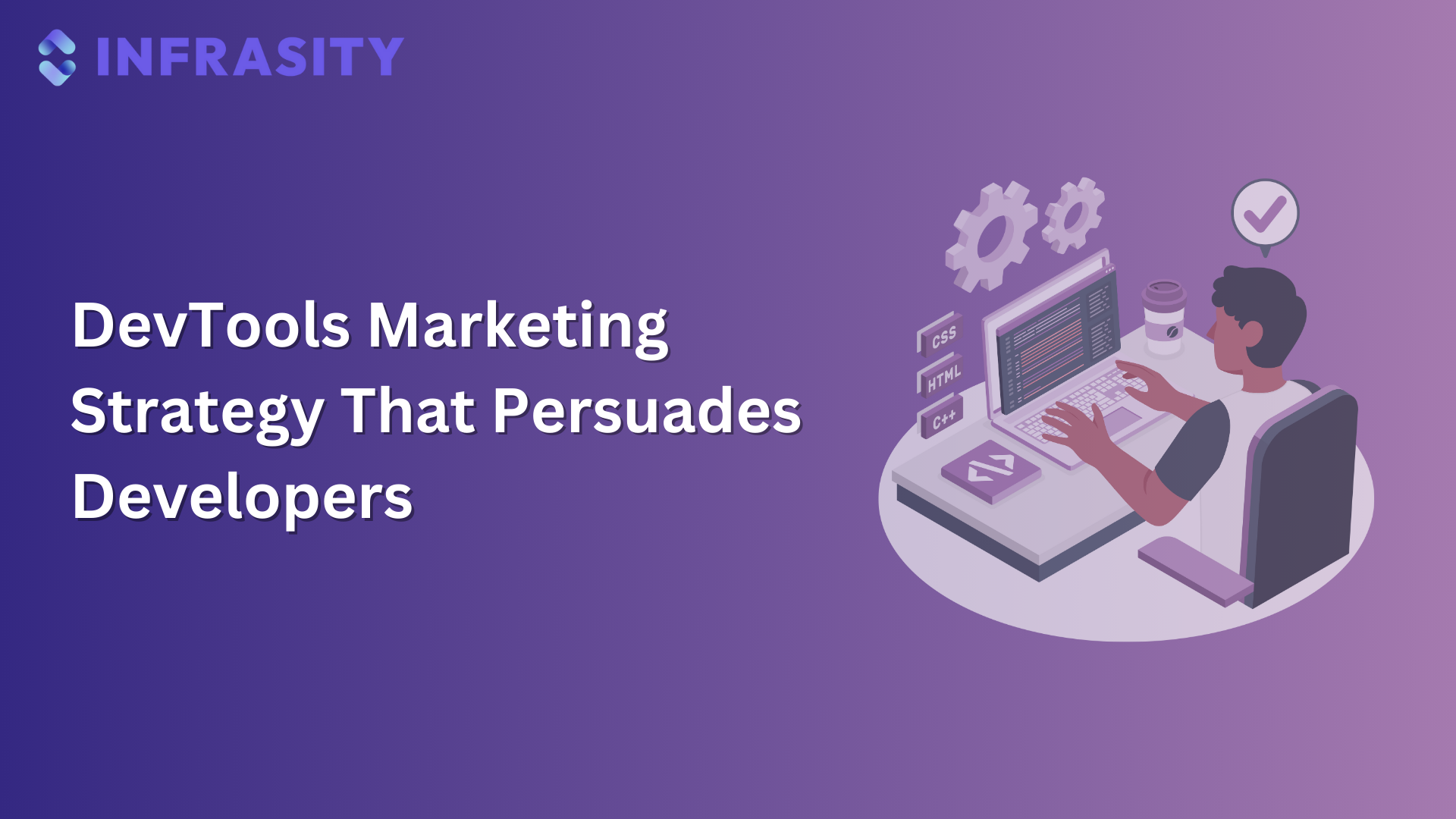Introduction
Launched your DevTool but struggling to get users? Let’s fix that!
You’ve put in the hours and built a DevTool that could make developers’ lives easier. But here’s the catch – getting them to notice it is a whole different challenge.
You’re not alone. Many great tools get lost in the noise because marketing to developers isn’t like marketing to everyone else. They’re skeptical, they ignore ads, and they value authenticity over sales tactics. So, how do you get their attention? How do you make them see the real value of what you’ve built?
This article will introduce you to DevTool marketing strategies used by both early-stage startups and established companies. But before we dive in, let’s first understand what DevTools actually are.
What are DevTools?
DevTools are a set of software applications or platforms that help developers build, test, and deploy software applications efficiently. These tools automate various stages of the development lifecycle, such as coding, debugging, version control, and deployment. This allows developers to spend more time creating high-quality software.
Many SaaS products have been launched in the dev market to date. For example, 13 DevTool companies were supported by Y Combinator in 2024. They were Hatchet, Downlink, Ocular AI, Marblism, OpenFoundry, Silogy, Spur, Zep AI, Integuru, Fume, Renderlet, Dragoneye, Million.
One of these DevTools – Ocular AI, is a powerful developer tool that helps developers automate data annotation, reduce manual effort, and ensure high-quality datasets for AI models. Its Foundry platform streamlines labeling, versioning, and workflow management, while Bolt provides expert-driven annotation for accuracy. This enables developers to focus on building and refining AI models instead of managing complex data preparation.
Let us dive into the smart strategies you should utilize for marketing developer tools.
Here’s How You Can Level Up Your DevTool Marketing Game
To successfully market a DevTool, you need more than just a great product – you need a strategy that speaks directly to developers. Infrasity has partnered with 50+ DevTool companies, and here are some of the strategies that might be relevant to your marketing:
1. Understand What Developers are Looking for
DevTools cater to developers; therefore, it is crucial to understand what they are looking for. It’s not just about developers in general; there are different sub-domains in the field: web, software, DevOps, mobile, back-end, full-stack, and front-end. Identify the type of developers that come under your target audience and build your developer marketing strategy accordingly.
For instance, Aviator is a GitHub automation tool designed for high-velocity engineering teams, streamlining pull request workflows, automating merges, and accelerating CI pipelines. Their developer audiences are DevOps Engineers, Infrastructure Engineers, Software Developers, and Site Reliability Engineers (SREs).
Software developers need a clean, conflict-free path to merge their code without constant rebasing or broken builds; Aviator’s Merge Queue handles this by automating and sequencing merges against the latest main branch. SREs and infrastructure engineers care deeply about safe, predictable deployments; Aviator’s Releases feature gives them structured release pipelines with automated promotion, rollback, and tracking. Code reviews are a critical control point for DevOps engineers. Aviator’s Flex Review enables dynamic, rule-based reviewer assignment, helping enforce standards without bottlenecks.
Each feature maps directly to a pain point faced by that specific role, meaning that developer marketing strategies can be planned based on each audience’s needs.
The State of Developer Marketing 2023/2024 Report stated that 78% of the participants (developer marketers) enjoyed understanding the developers they target. This sets the stage for creating a robust marketing strategy and makes it more efficient.
Additionally, it is imperative to understand that developers are not attracted to just hyped products but something that doesn’t seem like it’s marketed. It’s easy to spread awareness about your product with flashy marketing campaigns, but developers look for products that address their concerns and make their development experiences and workflow easier. So, planning a marketing strategy based on their mindset can be lucrative.
Read this article further to know what you should do next after the audience research.
2. Focus on Valuable Technical Content
It is often said that "Content is King." Although the content itself is fundamental to developing brand awareness, engagement, and conversions, it also comes down to providing the right SEO-optimized content and context. Developers are not impressed by flashy marketing content. Therefore, align the context with their workflow and solve their real-life challenges.
Developers constantly learn about new tools and methods to upskill themselves. Tap into that. Create technical content that teaches them something new, which is your new product or feature. It can be how-to guides, use case guides, workflow diagrams, white papers, and technical blogs. Add code snippets to make them understand your product better. But again, it should be contextual in a way that explains the "why" and "what" factors along with "how". Even Y Combinator-backed DevTool companies like Supabase, Replit, and Teleport focus on deep technical content.

For example, Supabase is an open-source Firebase alternative. This DevTool company creates contextual technical content by educating developers through how-to guides, use case examples, workflow diagrams, and hands-on tutorials. Instead of just listing features, Supabase explains the why, what, and how with real-world applications like "Adding generative Q&A to your Next.js site."
It is a contextual technical content explaining:
What: A guide on implementing vector search in a Next.js app using Supabase's AI-powered features, where vector search finds similar items based on meaning rather than exact words.
Why: Helps developers build intelligent search functionality by leveraging embeddings and Supabase’s database capabilities.
How: Provides step-by-step instructions, including setting up a Supabase project, generating embeddings, storing vectors, and querying them efficiently.
Therefore, by creating such educational and marketing developer content, you are not just focusing on promoting your DevTool but also providing solutions to developers through your product. Additionally, if your team of developers supervises or creates the content, it will build more credibility amongst your target users.
3. Build Your Presence on Product Hunt & Dev Hunt
Product Hunt and Dev Hunt are online marketplaces where developers launch new tools and products, featuring a voting system that helps the most popular and useful products gain visibility through community upvotes.
Launching your DevTool on these platforms can be a great Product-Led Growth (PLG) tactic that helps early-stage startups drive adoption by putting the product directly in the hands of users. These platforms attract developers, product managers, and early adopters. They enable enterprises to gather real-time feedback, validate positioning, and attract first users through hands-on experience. The exposure often leads to SEO benefits via high-authority backlinks and helps teams refine onboarding flows, messaging, and visuals.

For example, an early-stage startup, Corbado, successfully leveraged Product Hunt by launching their passkey DevTool, achieving the #1 Developer Tool of the Week and #4 Product of the Day in January 2024. This led to a 2x increase in website traffic and 4x more sign-ups compared to their daily average.
4. Utilize the Bait-and-Hook Strategy

Once the developers have consumed your technical content, they are likely to be intrigued about testing your product. Or they may have heard about your product and want a hands-on experience.
Utilize the bait-and-hook strategy and offer a free or low-cost product (the bait) to attract developers. This will allow them to understand your product’s functionality, compatibility, and value within their workflows. Ensure zero-friction onboarding with CLI-based setup, instant sign-up, and minimal steps. Then, monetize through premium features, subscriptions, or enterprise plans (the hook).
For instance, Postman is an API development tool company that offers developers a hands-on experience for free. This strategy attracts individual developers as well as small teams of developers, where it provides the necessary tools for API development, testing, and collaboration.
Then, it offers a paid subscription to developers who want to utilize advanced features like API monitoring, mock servers, team collaboration tools, and enhanced analytics.
5. Build a Strong Developer Community
Developers are the best people at marketing to developers. They will speak for your product when you build a strong developer community. Therefore, develop communities on platforms like Discord, Hacker News, Slack, and GitHub.
This will enhance your interactions with the community as well as peer-to-peer interactions, fostering a strong developer community. However, ensure that your organization is active in your community. You can designate a Developer Community Manager, for that matter. Make them participate in discussions and gather feedback while answering the developer’s queries. This will not only help in marketing developers' tools but also help you understand the improvements you should make to your product to increase product adoption.

For example, Railway, a developer tool, has built a strong developer community through Discord, GitHub, and X. On Discord, developers connect for troubleshooting, feature discussions, and onboarding help. As you can see in the above image, the README file is shared, which highlights the rules to be followed by the Railways’ community.
Additionally, their GitHub hosts open-source projects like "awesome-railway," allowing contributions and issue tracking. Meanwhile, X (formerly Twitter) serves as a platform for updates, feature announcements, and community interaction. Collectively, these channels work together to foster an interactive ecosystem that enables developers to learn, interact, and engage with one another.
6. Let the Developer Advocates Do the Talking
Developer advocates are loyal users who love your DevTool. They are technical experts who bridge the gap between developers and a company’s product or platform. Their hands-on experience with your DevTool gives them credibility, making their advocacy feel more authentic than traditional marketing.
Hiring these passionate developers strengthens brand presence by:
- Creating high-value content: blogs, tutorials, and videos that educate users.
- Engaging at conferences: building trust through real-world insights.
- Driving organic adoption: building trust and community-based growth by enabling authentic engagement, offering real solutions, and facilitating product adoption between peers.

For instance, Microsoft’s Cloud Advocates engage developers through education-based content, open-source contributions, and direct feedback loops, ensuring their cloud and AI tools remain relevant, developer-friendly, and widely adopted. By embedding advocacy into its marketing strategy, Microsoft enhances trust, improves product quality, and secures long-term user loyalty.
Here’s an example of the content created by a Developer Advocate at Microsoft, Aaron Powell. He has written many articles on the .NET Blog providing guidance and tips on web development and .NET technologies.

Moreover, Ian Douglas has worked as a Developer Advocate at Postman for nearly two years, where he’s been actively involved in educating developers on API best practices. During his time at Postman, he has spoken at several conferences on topics such as API-first development, testing workflows, and improving the developer experience with better tools.
Wrapping Up
Marketing a DevTool isn’t about selling; it’s about helping developers solve real problems. Give them a free trial to explore, get your tool in front of them through Product Hunt and Dev Hunt, and build trust with developer advocacy. Keep them engaged with technical content and a strong developer community. Also, track what’s working. Measure adoption, engagement, and feedback to keep refining your developer marketing strategy.
If you are looking for a technical writing service, partner with agencies like Infrasity to create content that actually speaks to developers. We have provided technical content services to several DevTool companies like DevZero, Aviator, Daytona, and Lovable.dev.
FAQs
1. What is a DevTool Used for?
A DevTool (developer tool) aids developers in creating, testing, debugging, and deploying software faster. It streamlines workflows, automates repetitive tasks, and enhances code quality throughout the development life cycle.
2. When Should You Launch on Product Hunt or Dev Hunt During Your Product Lifecycle?
The best time to launch on Product Hunt or Dev Hunt is when you have a clear value proposition, a reliable MVP, and a frictionless onboarding experience. Your product should work well and be compelling enough for early adopters to provide feedback, and it should have enough traction, even if it’s not fully featured.
3. How Do You Calculate the ROI of Technical Content Like Product Docs or Open-source Repos?
You can track the return on investment (ROI) through metrics like page views, time on page, and conversions (e.g., sign-ups or GitHub stars). For deeper insight, link content to product usage data, like activation rates after a tutorial or contributions after reading repo docs. Qualitative signals like community engagement, backlinks, and support deflection also indicate long-term value.
4. Is DevTool Marketing Different From Traditional Product Marketing?
Absolutely. DevTool marketing is less about selling and more about educating and enabling. Developers don’t respond to the hype; they want hands-on experience, clear documentation, real use cases, and technical depth. Trust, credibility, and community matter more than flashy campaigns. It’s about proving value through the product itself, not just talking about it.
5. Is DevRel a Part of DevTool marketing?
Yes, DevRel is a key part of DevTool marketing, but with a distinct focus. While DevTool marketing drives awareness and adoption through messaging, campaigns, and positioning, DevRel builds trust by engaging directly with developers, creating technical content, and supporting community growth.



